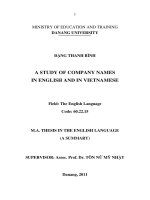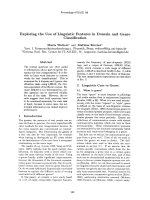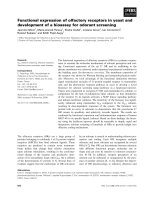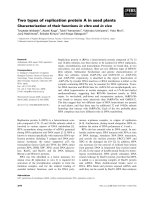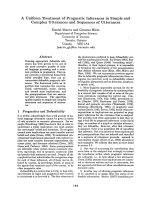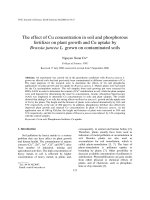Difficulties of huflit freshmen in pronunciation and recommendations graduation paper, major translation and iterpretation
Bạn đang xem bản rút gọn của tài liệu. Xem và tải ngay bản đầy đủ của tài liệu tại đây (957.33 KB, 62 trang )
HO CHI MINH UNIVERSITY OF FOREIGN LANGUAGES AND
INFORMATION TECHNOLOGY
DEPARTMENT OF FOREIGN LANGUAGES
CAUSES MAKING HUFLIT FRESHMEN’S
PRONUNCIATION DIFFICULT AND
RECOMMENDATIONS
Student: Pham Hong Thanh Vy
Student’s ID: 15DH710172
Advisor: Ms. Nguyen Thi Xuyen (M.A.)
TABLE OF CONTENTS
LIST OF FIGURES ................................................................................................................... iii
LIST OF ABBREVIATION ...................................................................................................... iv
ACKNOWLEDGEMENT ........................................................................................................... v
ABSTRACT ............................................................................................................................... vi
CHAPTER 1: INTRODUCTION .............................................................................................. 1
1.1 Research Background ........................................................................................... 1
1.2 Research Objectives .............................................................................................. 1
1.3 Research scope ...................................................................................................... 1
CHAPTER 2: LITERATURE REVIEW.................................................................................... 3
2.1 Motivation of English phonetics learners ............................................................. 3
2.2 Differences between English and Vietnamese sounds .......................................... 4
CHAPTER 3: METHODOLOGY .............................................................................................. 9
3.1 Research subject.................................................................................................... 9
3.2 Course information ............................................................................................... 9
3.3 Questionnaire ........................................................................................................ 9
3.4 Interview questions ............................................................................................. 10
3.5 Research methodology ........................................................................................ 10
CHAPTER 4: DATA ANALYSIS AND CONCLUSION ........................................................ 11
4.1 Confidence scale of freshmen’s pronunciation .................................................. 11
4.2 Pronunciation of /t/ sound in English and Vietnamese and pronunciation of / θ/
sound and /th/ sound.................................................................................................. 12
4.3 Pronunciation of /kw/ and /w/; / ŋ/ in English and Vietnamese......................... 14
4.4 Pronunciation of /ʃ/ and /ş/ ................................................................................. 16
4.5 Pronunciation of /ð/ and /d/ ............................................................................... 17
4.10 Pronunciation of /æ/ and schwa ....................................................................... 18
4.11 Pronunciation of /tʃ/ and /dʒ/ ........................................................................... 20
4.12 Pronunciation of /ʒ/ ........................................................................................... 21
4.13 Pronunciation of same spelling words, homophones and silent sounds .......... 22
4.14 Pronunciation of final sounds ........................................................................... 25
4.15 Pronunciation of “_s/es” and “_ed”.................................................................. 26
4.16 Pronunciation of long vowels ............................................................................ 28
4.17 Pronunciation of consonant clusters ................................................................. 29
4.18 Pronunciation of stress ...................................................................................... 30
4.19 Conclusion ......................................................................................................... 33
CHAPTER 5: RECOMMENDATIONS .................................................................................. 37
5.1 For the leaners ..................................................................................................... 37
i
5.1.1 Self-study ..................................................................................................................................... 37
5.1.2 Study with others ...................................................................................................................... 40
5.2 For the lecturers .................................................................................................. 42
5.2.1 Teaching activity....................................................................................................................... 42
5.2.2 Checking activity ...................................................................................................................... 43
CHAPTER 6: CONCLUSION ................................................................................................. 44
6.1 Limitations .......................................................................................................... 44
6.2 Conclusion ........................................................................................................... 44
REFERENCES ......................................................................................................................... 46
APPENDIX 1: QUESTIONNAIRE (FOR STUDENTS) ...................................................... 49
APPENDIX 2: INTERVIEW QUESTIONS (FOR LECTURERS) ....................................... 55
ii
LIST OF FIGURES
Figure 1: Confidence scale of freshmen’s pronunciation ................ 11
Figure 2: Pronunciation of /t/ sound in English and Vietnamese .....12
Figure 3: Pronunciation of / θ/ sound and /th/ sound ...................... 13
Figure 4: Pronunciation of /kw/ and /w/ ........................................ 14
Figure 5: Pronunciation of English and Vietnamese / ŋ/ ................. 14
Figure 6: Pronunciation of /ʃ/ and /ş/ ............................................ 16
Figure 7: Pronunciation of /ð/ and /d/ ........................................... 17
Figure 8: Pronunciation of /æ/ and schwa ...................................... 19
Figure 9: Pronunciation of /tʃ/ and /dʒ/ ......................................... 20
Figure 10: Pronunciation of /ʒ/ ....................................................... 21
Figure 11: Pronunciation of same spelling words, homophones
and silent sounds ............................................................................ 23
Figure 12: Pronunciation of final sounds ........................................ 25
Figure 13: Pronunciation of “_s/es” and “_ed” ............................... 26
Figure 14: Pronunciation of long vowels ........................................ 28
Figure 15: Pronunciation of consonant clusters .............................. 29
Figure 16: Pronunciation of stress .................................................. 30
iii
LIST OF ABBREVIATION
DFL: Department of Foreign Languages
ESL: Learning English as Second Language
Huflit: Ho Chi Minh University of Information Technology and Foreign
Languages
iv
ACKNOWLEDGEMENT
I would like to express my genuine appreciation to my advisor – Ms.
Nguyen Thi Xuyen, who provides me a lot of guidance and supports during
the process of this graduate thesis.
Moreover, I would like to thank the lecturers - Ms. Truong Kim Ngoc,
Mr. Huynh Phuoc Hai, Mrs. Le Thi Bao Ngoc, Mr. Nguyen Huy Khai who
spent their time to have an interview about the real situations of freshmen’s
pronunciation so that I can have an objective viewpoint about the problems
that the students are facing in my research.
Finally, I would like to appreciate my family supports, especially my
mother who always cheers me up and gives me some advice when I am in
hardship.
v
ABSTRACT
Pronunciation plays an important role in speaking and listening skills.
However, it is a truth that most Vietnamese students in general and Huflit’s
students, in particular, have difficulties in pronouncing English words. They
find hard to make quick progress in speaking and listening skills although
they practice these two skills industriously. The aims of the study; therefore,
are to figure out students’ problems in pronouncing English, then suggest
some solutions for not only Huflit’s freshmen of DFL but other departments’
as well. The questionnaire was given out to two hundred and fifty Huflit’s
freshmen in DFL to find out the causes which make their pronunciation
become an obstacle in communications. Moreover, some lecturers in-charge
were asked four questions about the Huflit’s freshmen’s pronunciation during
phonetics course. After the data were collected, the findings were analyzed
and solutions were recommended. The paper is ended with the Limitations
part and a further suggestion for the next research.
vi
CHAPTER 1: INTRODUCTION
1.1 Research Background
In the 21st century, the importance of learning English becomes more
and more recognizable. Therefore, the need for learning the language has
increased dramatically, especially in Vietnam. Therefore, many students
choose English as their major at university. Huflit’s freshmen of the Foreign
Languages Department (DFL) also follow this hot trend. They may see the
potential in learning English for their future careers. However, though they
choose to learn English professionally, they sometimes want to give up due to
their failure in communication. This fact may be caused by some reasons.
They usually pronounce some English sounds incorrectly and stress flatly,
which may cause misunderstandings to listeners. Moreover, there are not
many tactics for students to distinguish the differences between English
phonetics and Vietnamese phonetics, so the act of improving their
pronunciation takes a lot of time and effort.
1.2 Research Objectives
The study aims at figuring out the real reasons in pronunciation that
making Huflit’s freshmen a big problem and then finds out the solutions to
help them improve their pronunciation as well as speaking skills.
1.3 Research scope
Our hypothesis in this research is that first-years students’ bad
pronunciation mainly caused by the different sounds, the way of putting stress
and intonation between English and Vietnamese. Hence, our research focuses
1
on the problems faced by students in studying the course “Phonetics” in the
aspects of pronouncing sounds in English, word stress, sentence stress, and
intonation. We are not targeting to the learners’ awareness or learners’
characters, which affect their pronunciation outcome.
2
CHAPTER 2: LITERATURE REVIEW
There is no doubt that English and Vietnamese sounds have
differences, which causes difficulties for not only learners but also teachers.
As Roach (2000; 6) suggests that pronunciation should be taught as
“communication games” since it is difficult to teach and practice. The author
also says that teaching pronunciation has not been favored. There has been a
lot of research so far on the phonetic system of English and Vietnamese,
which can help reduce the stress for foreign language students.
2.1 Motivation of English phonetics learners
First, according to Hamann and Schmitz (2005, 3), there are three main
reasons that students should learn phonetics and phonology including two
reasons related to foreign languages. One is for studying and the other is for
teaching. They mention that foreign learners learning English phonetics can
improve listening ability and fix their own pronunciation mistakes. Moreover,
they can teach English to other people. In this research, the writers also point
out that spelling and pronunciation in English are not the same. According to
Cao Xuan Hao (2017, 207), “Quốc Ngữ” characters focus on transcribing the
sounds of Vietnamese. Therefore, this side of English makes Vietnamese
learners feel much more difficult to pronounce words since our mother
tongue’s spelling and pronunciation is connected. The learners in general
usually pronounce English words by looking at the letters.
3
2.2 Differences between English and Vietnamese sounds
Besides, Vietnamese and English phonetics is different by nature.
Regarding to syllables, most of them carry meanings in Vietnamese, while
English words are made up of many syllables. For example, “khoẻ” means
“healthy” in English. As you can see in the example above, besides having a
meaningful syllable, Vietnamese words have tone marks, which English does
not have. In addition, Vietnamese is monosyllabic while English is
polyphonic, (Cao Xuan Hao, 2017,21). According to the same author (1998,
33), Vietnamese syllables are also morphemes, and the final consonants in
Vietnamese do not glide to the initial vowel of the next syllable like English
do. This difference makes Vietnamese students feel difficult in speaking and
listening even they know how to pronounce an English word correctly, but it
is harder to pronounce “naturally” in a phrase or in a sentence. For instance,
in the phrase “Come in”, the native speakers will pronounce as /kʌmɪn/ not
/kʌm ɪn/ as many Vietnamese students usually pronounce. Even though the
pronunciation of the second language learners is not wrong, it is not natural.
Another difference is that Vietnamese is nonlinear language but English is (or
European languages in general), stated by Cao Xuan Hao (2017, 34). He
explains that the fixed position in components of Vietnamese made the “order
of time” in vowels, consonants, and semi-consonants are not significant. Doan
Thien Thuat (2011, 156) adds that “phonemes” are the smallest unit of the
hearing sound structure, while “syllables” are the smallest unit of sound
structure. He also emphasizes that vowel and consonants are considered as the
two biggest collections of phonemes. Roach (2000, 11) says that vowel and
consonant definitions are varied in different languages, and the definitions of
vowels and consonants are still in discussion.
4
Secondly, Cao Xuan Hao (2017, 45) states that Vietnamese is an
isolated language, which means “tiếng” is the most basic unit of Vietnamese
and it is also a morpheme in the language. Cao Xuan Hao (2017, 52) also
claims that because of the order of “Quốc Ngữ” characters, the difference
between English (European languages in general) and Vietnamese are hard to
be seen. He means that the order of ”Quốc Ngữ” characters makes people
think that the sounds of Vietnamese are also pronounced in the same way as
the English sounds. He says that English sounds are the movement on three
main factors named respectively “words”, “morphemes” and “phonemes”,
while they seem to be associated on the same levels named “tiếng” in
Vietnamese (2017, 57). He also adds that there is a difference in the
awareness of phonemes. In Vietnamese, people recognize “phonemes” as
“active acoustics” and the Vietnamese hear the syllables like how they are.
For English speakers, they recognize phonemes as ”stative acoustics” because
of the need to distinguish the order of linear.
Thirdly, Roach (2000, 40) points out that English is an inflection
language, which means “phonemes” are the smallest abstract unit of English
sound system or speech. English has consonant clusters, which may consist of
more than three consonants at most (e.g: street) if they are initials in a word
and have up to four consonants when they are in final position (belch). Cao
Xuan Hao (2017, 44) says that when clusters in English were more than three
consonants, it would be hard to pronounce.
Next, even though Vietnamese does have diphthongs like most of the
languages, stated by Doan Thien Thuat (2011, 165), (for example ngôi sao),
the way of pronunciation of those in English is still confused for Vietnamese
5
people. Roach (2000, 21) indicates that non-native speakers’ accents can be
recognized thanks to diphthongs because they pronounced diphthongs as a
“pure vowel” without gliding from the longer and stronger first vowel part to
the shorter and lighter pronounced second vowel. Moreover, in English, there
are triphthongs, which are a combination of three vowel sounds with gliding
from the first one to the second one then to the third one with fast
pronunciation and continuity. Roach (2000, 24) considers triphthongs as the
most complex English sounds when mentioning about pronouncing vowels.
He also adds the “vowel movement” in English is not easy to be recognized
excluding when these sounds are pronounced slowly. Meanwhile, Cao Xuan
Hao (2017, 47) shows that Vietnamese has fixed syllable structures, which
mean there is no “gliding” phenomenon in pronouncing Vietnamese words.
He also points out that people consider a vowel in vocalic segments as an
orthoepy. He claims that Vietnamese and English (Europe languages in
general) are different in the phonetic system, so they could not be analyzed as
the same method.
Cao Xuan Hao (2017, 21) also states English is different from
Vietnamese in the prosodic and suprasegmental phenomenon. He adds that
tone marks of Vietnamese are called prosodic or suprasegmental, which are
considered to be opposite to inherent and segmental distinguishers in English.
According to Doan Thien Thuat (2011, 185-186), tone marks seem to be more
popular in Asian languages such as Vietnamese than in European languages.
It is defined as the change of the height of tone. Cao Xuan Hao (2017, 19)
points out the height of tone of English is different from since the intonation
of English is made differently in a sentence. Moreover, the tone marks of
Vietnamese are considered as a difficult type of tone mark called contour
6
tone. In English, people use stress to distinguish the word height. To be
specific, people who speak English have three ways to make stress. They can
use the amplitude of sounds, the change of the tone height, or the change of
duration to express stress. They are the differences between two languages in
suprasegmental distinguishers that make people who speak Vietnamese feel
confused in pronunciation because the stress in English is free but constant
(Doan Thien Thuat 2011, 188) at the same time. Therefore, Vietnamese
learners usually find it hard to remember all the stress or the stress rules while
learning English since it is not familiar to them. This is one of the reasons
why Vietnamese students usually have trouble in pronouncing English with
the correct tone. If Vietnamese has tone marks, English has stress, which
causes difficulties for foreigners in learning the language. Non-native learners
are confused to know which syllable is stressed in an English word if they do
not remember well or have any background of phonetics and phonology.
Roach (2000,97) explains that English is not easy to point out the stress since
it is different from French and Polish whose stress is determined by the
relation with the word’s syllables. Therefore, learners have to learn the stress
of each word individually. Moreover, he also mentions the stress rules are just
relatively helpful as there are many exceptions, and they are too complicated
to understand for foreign learners as well. Prefixes and suffixes also have
influences on how the stress of a word is determined stated by Roach (2000,
105, 107). He also indicates that there are a few rules of compound words’
stress but they are not credible to figure out when the first element or the
second element is stressed (2000, 108). Roach (2000, 109) claims stress
pattern is not constant because of two reasons. One is the influence of the
stress of the following words. The other is the disagreement of stress
placement of the speakers. Word-class pairs also confuse foreign learners.
7
Roach (2000, 110) states that these pairs include two words with the same
spelling, but they are different from each other by stress placement due to
word class. Another difference is that Vietnamese is a tone language while
English is a non-tone language stated by Roach (2000, 154). Therefore,
English people find it weird to approach Vietnamese and vice versa. Because
of that, the tone function in English is harder to identify than in Vietnamese.
Roach (2000, 55) points out that glottalization (mostly used by young
English speakers) occurring before /p/, /t/, /k/, /tʃ/ in some occasions and
foreigners will find it hard to understand the rules. However, the use without
glottalization before these sounds is still considered as correct pronunciation.
Therefore, foreigners should keep the pronunciation in a simpler way for
them if it is still correct.
To sum up, English and Vietnamese are different in spellings and
pronunciation rules, the smallest unit of sounds, stress and tone marks, etc.
Therefore, most Vietnamese learners find difficult in pronouncing English in
the aspects of making sounds, especially consonant clusters and diphthongs,
using the word stress and tone in sentences.
8
CHAPTER 3: METHODOLOGY
3.1 Research subject
The subjects of this research are the freshmen of DFL, who are
studying the second semester at Huflit. Most of them have been studying
English for more than seven years. However, their pronunciation or speaking
skills are not focused at lower levels. As a result, DFL lecturers feel tense to
teach them in speaking and listening classes.
3.2 Course information
A survey is carried out in four classes including 250 students who are
studying English Phonetics in their second term of university. They studied
Introduction to Linguistics in the first semester, so they have basic ideas about
the phonetics in both languages. There are two hundred and forty six
questionnaires collected after the survey. However, there is one inappropriate
result since it has many undone answers.
3.3 Questionnaire
The survey includes twenty-three questions with three multiple-choice
options. In the last choice, which is “others”, they could fill in their own
opinions. The first question is about their evaluation of the pronunciation of
themselves. This shows the confidence of students in their pronunciation on
the scale from 1 to 10. Questions from 2 to 14 ask students about some
specific sounds that Vietnamese people usually feel difficult to pronounce
9
correctly when speaking English. These questions are asked with the purpose
of figuring out what sounds the students find them most difficult to
pronounce. The rests are questions relating to confusing situations in
pronouncing English words such as homophones, silent sounds, final sounds,
etc., and problems about word stress and sentence stress.
3.4 Interview questions
Moreover, some lecturers teaching Phonetics for DFL were interviewed
to have a subjective view to assess the pronunciation of first-year students.
There are four questions. The first question is about the attitude of freshmen
when they are corrected by the lecturers. The second and third questions ask
the lecturers to list out some difficult sounds that students face and the
reasons causing these problems. The last question is about the evaluation of
the learners’ English sound acquisition in the class.
3.5 Research methodology
In our research, the quantitative methodology was applied.
Data
analysis was conducted to find out the drawbacks of learners and what sounds
the freshmen usually mispronounce or what problems they have while
pronouncing English words. The analysis was manually carried out by
counting the numbers of choice in each question. Based on the results, which
are illustrated with graphs and charts, we can have many meaningful findings
and conclusions. The opinions of the lecturers are recorded and summarized
to analyze how well freshmen pronounce English sounds, how they usually
struggle to pronounce.
10
CHAPTER 4: DATA ANALYSIS AND CONCLUSION
4.1 Confidence scale of freshmen’s pronunciation
QUESTION 1
9.8%
16.3%
1-4
5-7
8-10
73.9%
Figure 1: Confidence scale of freshmen’s pronunciation
The first question is asked to figure out the confidence of students on
their own pronunciation. Most of the students (73.9%) are quite confident to
mark their own pronunciation from 5 to 7. A small part of students (9.8%)
choose from 8 to 10 as they are the most confident ones. The rest (16.3%)
admit that their pronunciation is quite bad, so they choose from 1 to 4. These
results show that students are quite confident in their pronunciation.
11
4.2 Pronunciation of /t/ sound in English and Vietnamese and
pronunciation of / θ/ sound and /th/ sound
QUESTION 2
100%
90%
80%
70%
60%
YES
50%
NO
40%
OTHERS
30%
20%
10%
0%
NUMBERS OF STUDENTS
Figure 2: Pronunciation of /t/ sound in English and Vietnamese
The next two questions (Figure 2 and Figure 3) are about two pairs of
sounds /t/, /θ/ in English and /t/, /th/ sounds in Vietnamese. They are the most
familiar sounds in English. With the result of 86.9% and 74.3% respectively
we can see most of the freshmen pronounce these sounds well without being
mistaken with Vietnamese sounds. For /t/ sound in English, there is only
10.6% of students report that they pronounce the sound as /t/ in Vietnamese.
However, there is a bigger portion of 21.6% for /θ/ sound. It is easy to
understand since /θ/ sound is not included in the Vietnamese sound system
and it is hard to pronounce if the students do not pay attention to adjust their
tongue position during pronunciation process. Meanwhile, /t/ sound is quite
similar and has the same positions with /t/ sound of Vietnamese because they
are both alveolar plosive consonants. However, they are still different from
12
each other since the sound /t/ is a fortis sound, so it needs releasing more air.
Some students have another opinion that is they mispronounce /t/ sometimes.
A small portion pronounces the sound as /c/ in Vietnamese, which is quite
rare. A part of students claim that they cannot pronounce the sound /θ/
correctly all the time and still need more practice for better pronunciation. On
the contrary, the lecturers evaluate that there are many students
mispronouncing or having struggling time when pronouncing these two
sounds.
QUESTION 3
OTHERS
NO
YES
74.3%
0%
50%
100%
Figure 3: Pronunciation of / θ/ sound and /th/ sound
13
4.3 Pronunciation of /kw/ and /w/; / ŋ/ in English and Vietnamese
QUESTION 4
0.4%
13.1%
YES
NO
OTHERS
86.5%
Figure 4: Pronunciation of /kw/ and /w/
QUESTION 5
100%
90%
80%
70%
60%
YES
50%
NO
40%
OTHERS
30%
20%
10%
0%
Figure 5: Pronunciation of /ŋ/ in English and Vietnamese
Question 4 and question 5 ask students about two other pairs of sounds
/kw/, /w/, English and Vietnamese /ŋ/. The freshmen are quite assured to
14
pronounce these two English pairs of sounds correctly with a big percentage
of students, 86.5% for /kw/ sound and 86.9% for /ŋ/ sound. Over 13% and
11% students in question 4 and question 5 have the problems to
mispronounce these sounds. The reasons may be from the habit of
pronouncing Vietnamese sounds instead of English sounds since the letter
“ng” of the sound /ŋ/ is the same as the sound /ŋ/ of Vietnamese, but they are
not pronounced in the same way. /kw/ and /w/ commonly have the same
spelling “qu”, but /kw/ in English needs learners to pronounce the sound /k/
before the sound /w/. For the sound /ŋ/, the same situation happens. The
difference is that /ŋ/ sound in Vietnamese is q a plosive and sonant sound
while /ŋ/ sound in English is a nasal sound. The students need to be careful
with their lips position while pronouncing, especially for the final position of
/ŋ/ in both language. The final /ŋ/ sound in Vietnamese requires the speakers
close their mouth to pronounce, while the English sound asks students to open
their mouth instead. Some of the students say that they cannot distinguish the
/ŋ/ sound in English and Vietnamese.
15
4.4 Pronunciation of /ʃ/ and /ş/
QUESTION 6
OTHERS
NO
YES
0%
20%
40%
60%
80%
100%
Figure 6: Pronunciation of /ʃ/ and /ş/
Question 6 asks students if they make the sound /ʃ/ correctly. As the
chart shows that 93.5% of students are quite confident in pronouncing this
sound with a high percentage. Only 4.1% states that they have difficulties in
pronouncing /ʃ/ sound. This problem is caused because the /ʃ/ sound is quite
confused with /ş/ sound in Vietnamese. /ʃ/ sound is post-alveolar while /ş/
sound is retroflex. Retroflex sound is the sound made by the up and down curl
happening at the end of the tongue. This may be the reason why some of the
students cannot pronounce the /ʃ/ sound correctly because they are puzzled to
mispronounce as /ş/ sound in Vietnamese habitually. Nearly 3% of the
freshmen know that these two sounds are different, but they do not pronounce
exactly all the time, or they have a struggle in recognition of the difference.
The lecturers state that there are many students mispronouncing the sound,
16
but they do not recognize their errors. For instance, the students usually
pronounce /ʃ/ with /s/ in English such as “show” and “so”.
4.5 Pronunciation of /ð/ and /d/
QUESTION 7
4.1%
YES
30.6%
NO
OTHERS
65.3%
Figure 7: Pronunciation of /ð/ and /d/
The next questions are about /ð/ and /d/.
More than 65% of the
surveyed students say that they find easy to pronounce the sound well. There
are 30.6% having trouble while pronouncing the /ð/ sound. The reason is from
the confusion of Vietnamese students about the sound /ð/ and /d/. The sound
/ð/ is mispronounced as /d/ because there is no /ð/ sound in Vietnamese sound
system. Thus, /d/ sound in Vietnamese is an alveolar consonant, which is
different from dental /ð/ in English. The difference of position makes students
find it difficult to pronounce /ð/ correctly because Vietnamese sound system
has no dental sounds, which is produced by touching speakers’ tongue to their
teeth. Some students (4.1%) state that they still mispronounce the sound
17
sometimes. Other opinions say they have improved the pronunciation of this
sound after taking the Phonetics course. The lecturers also say that the
students have problems with pronouncing /ð/ sound because they do not put
their tongue behind the teeth while pronouncing /ð/.
4.10 Pronunciation of /æ/ and schwa
The next two questions are about vowels. According to Figure 8, about
82% of the students are confident with /æ/ sound. Nearly 15% of them has a
lot of struggle in pronouncing this sound. This sound is confused with /a/ and
/e/ sound for people who are used to using Vietnamese sound system.
Moreover, this sound is not included in our mother tongue’s sounds, so it is
usually mispronounced as /a/ in Vietnamese. Only a few students say that
they are not sure if their pronunciation of this sound is right or wrong, and
they are still confused while pronouncing the sound. The lecturers’ view
about the pronunciation of this sound is that the students need to be careful
while pronouncing /æ/ since there are many students mispronounce the sound
without recognition of their errors.
18

